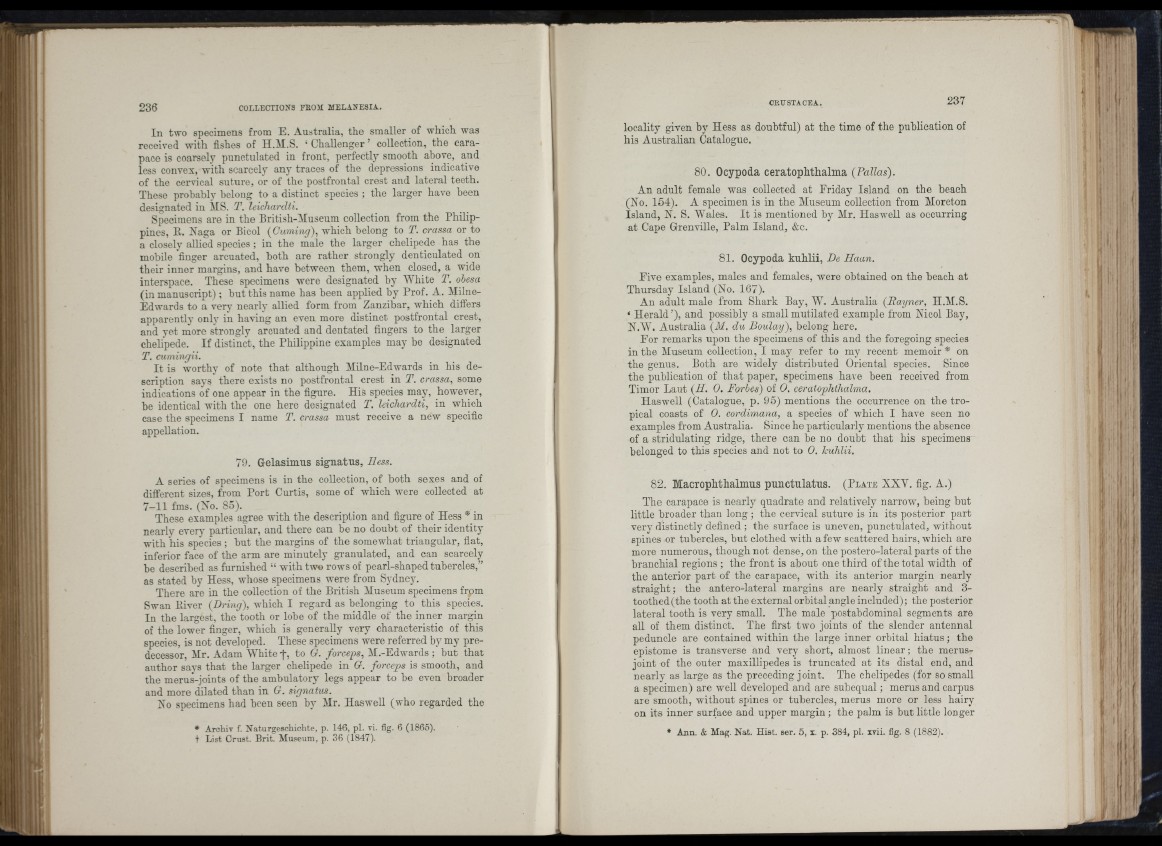
236 COLLECTIONS FEOM MELANESIA.
if
Í
p
In two specimens from E. Australia, the smaller of which was
received with fishes of H.M.S. ‘ Challenger ’ collection, the carapace
is coarsely punctulated in front, perfectly smooth above, and
less convex, with scarcely any traces of the depressions indicative
of the cervical suture, or of the postfrontal crest and lateral teeth.
These probably belong to a distinct species ; the larger have been
designated iu MS. T. Jeichardti.
Specimens are in the British-Museum collection from the Philippines,
B. Naga or Bicol (Cuming), which belong to T. crassa or to
a closely allied species; in the male the larger chelipede has the
mobile finger arcuated, both are rather strongly denticulated on
their inner margins, and have between them, when closed, a wide
interspace. These specimens were designated by AVhite T. obesa
(in manuscript); but this name has been applied by Prof. A. Alilne-
Edwards to a very nearly allied form from Zanzibar, which differs
apparently only in having an even more distinct postfrontal crest,
and yet more strongly arcuated and dentated fingers to the larger
chelipede. I f distinct, the Philippine examples may be designated
T. cumingii.
I t is worthy of note th at although Milne-Edwards in his description
says there exists no postfrontal crest in T. crassa, some
indications of one appear in the figure. His species may, however,
be identical with the one here designated T. leichardti, in which
case the specimens I name T. crassa must receive a new specific
appellation.
79. Gelasimus signatus, Bess.
A series of specimens is in the collection, of both sexes and of
different sizes, from Port Curtis, some of which were collected at
7-11 fms. (Xo. 85).
These examples agree with the description and figure of Hess * in
nearly every particular, and there can he no doubt of their identity
with his species ; but the margins of the somewhat triangular, fiat,
inferior face of the arm are minutely granulated, and can scarcely
be described as furnished “ with two rows of pearl-shaped tubercles,”
as stated by Hess, whose specimens were from Sydney.
There are in the collection of the British Museum specimens from
Swan Biver (Driuy), which I regard as belonging to this species.
In the largest, the tooth or lobe of the middle of the inner margin
of the lower finger, which is generally very characteristic of this
species, is not developed. These specimens were referred by my predecessor,
Mr. Adam AVhite f , to G. forceps, Al.-Edwards ; but that
author says that the larger chelipede in G. forceps is smooth, and
the merus-joints of the ambulatory legs appear to be even broader
and more dilated than in G. signatus.
Xo specimens had been seen by Mr. Haswell (who regarded the
* Archiv f. Naturgeschichte, p. 146, pi. vi. fig. 6 (1865).
t List Crust. Brit. Aluseum, p. 36 (1847).
&
« ■ -I I: 4.
CRUSTACEA. 237
locality given by Hess as doubtful) at the time of the publication of
his Australian Catalogue.
80. Ocypoda ceratophthalma (Pallas).
An adult female was collected at Eriday Island on the beach
(Xo. 154). A specimen is in the Museum collection from Moreton
Island, X. S. AAAles. I t is mentioned by Mr. HasweU as occurring
at Cape GrenviUe, Palm Island, &c.
81. Ocypoda kuhlii, De Haan.
Eive examples, males and females, were obtained on the beach at
Thursday Island (No. 167).
An adult male from Shark Bay, AV. Australia (Rayner, H.M.S.
‘ H e ra ld ’), and possibly a small mutilated example from Nicol Bay,
N.AV. Australia (AI. du Boulay), belong here.
Eor remarks upon the specimens of this and the foregoing species
in the Museum collection, I may refer to my recent memoir * on
the genus. Both are widely distributed Oriental species. Since
the publication of th at paper, specimens ha? e been received from
Timor Laut (H. 0. Forhes) of 0. ceratophthalma..
Haswell (Catalogue, p. 95) mentions the occurrence on the tropical
coasts of 0. cordimana, a species of which I have seen no
examples from Australia. Since he particularly mentions the absence
of a stridnlating ridge, there can he no doubt th at his specimens
belonged to this species and not to 0. kuhlii.
I I -H '
Í. I
S F I ,
f ■ f
.i
82. Macrophthalmus punctnlatus. (P la te XXV. fig. A.)
The carapace is nearly quadrate and relatively narrow, being but
little broader than long ; the cervical sutui’O is in its posterior part
very distinctly defined ; the surface is uneven, punctulated, without
spines or tubercles, but clothed with a few scattered hairs, which are
more numerous, though not dense, on the postero-lateral parts of the
branchial regions ; the front is about one third of the total width of
the anterior part of the carapace, with its anterior margin nearly
straight; the antero-lateral margins are nearly straight and 3-
toothed(the tooth at the external orbital angle included); the posterior
lateral tooth is very small. The male postahdominal segments are
all of them distinct. The first two joints of the slender antennal
peduncle are contained within the large inner orbital h ia tu s ; the
epistome is transverse and very short, almost lin e a r; the merus-
joint of the outer maxillipedes is truncated at its distal end, and
nearly as large as the preceding joint. The chelipedes (for so small
a specimen) are well developed and are snhequal; merus and carpus
are smooth, without spines or tubercles, merus more or less hairy
on its inner surface and upper margin ; the palm is but little longer
* Ann. & Mag. Nat. Hist. ser. 5, x. p. 384, pi. xvii. fig. 8 (1882).